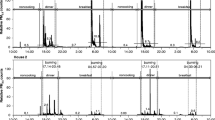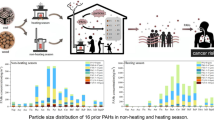Abstract
Polycyclic aromatic hydrocarbons (PAHs) are widespread environmental contaminants associated with various health risks including lung cancer. Indoor exposure to PAHs, particularly from the indoor burning of fuels, is significant; however, long-term large-scale assessments of indoor PAHs are hampered by high costs and time-consuming in field sampling and laboratory experiments. A simple fuel-based approach and statistical regression models were developed as a trial to predict indoor BaP, as a typical PAH, in China, and consequently spatiotemporal variations in indoor BaP and indoor exposure contributions were discussed. The results show that the national population-weighted indoor BaP concentration has decreased substantially from 46.1 ng/m3 in 1992 to 6.60 ng/m3 in 2017, primarily due to the increased use of clean energies for cooking and heating. Indoor BaP exposure contributed to > 70% of the total inhalation exposure in most cities, particularly in regions where solid fuels are widely utilized. With limited experimental observation data in building statistical models, quantitative results of the study are associated with high uncertainties; however, the study undoubtedly supports effective countermeasures on indoor PAHs from solid fuel use and the importance of promoting clean household energy usage to improve household air quality.




Similar content being viewed by others
References
Aunan, K., Ma, Q., Lund, M. T., & Wang, S. (2018). Population-weighted exposure to PM2.5 pollution in China: An integrated approach. Environment International, 120, 111–120.
Chen, Y., Shen, H., Smith, K. R., Guan, D., Chen, Y., Shen, G., Liu, J., Cheng, H., Zeng, E. Y., & Tao, S. (2018). Estimating household air pollution exposures and health impacts from space heating in rural China. Environment International, 119, 117–124.
Downward, G. S., van der Zwaag, H. P., Simons, L., Meliefste, K., Tefera, Y., Carreon, J. R., Vermeulen, R., & Smit, L. A. (2018). Occupational exposure to indoor air pollution among bakery workers in Ethiopia; A comparison of electric and biomass cookstoves. Environmental Pollution, 233, 690–697.
Du, W., Li, X., Chen, Y., & Shen, G. (2018). Household air pollution and personal exposure to air pollutants in rural China–a review. Environmental Pollution, 237, 625–638.
Du, W., Wang, J., Zhuo, S., Zhong, Q., Wang, W., Chen, Y., Wang, Z., Mao, K., Huang, Y., & Shen, G. (2021). Emissions of particulate PAHs from solid fuel combustion in indoor cookstoves. Science of the Total Environment, 771, 145411.
Duan, N. (1982). Models for human exposure to air pollution. Environment International, 8, 305–309.
Duan, X., Wang, B., Zhao, X., Shen, G., **a, Z., Huang, N., Jiang, Q., Lu, B., Xu, D., & Fang, J. (2014). Personal inhalation exposure to polycyclic aromatic hydrocarbons in urban and rural residents in a typical northern city in China. Indoor Air, 24, 464–473.
Ge, S., Xu, X., Chow, J. C., Watson, J., Sheng, Q., Liu, W., Bai, Z., Zhu, T., & Zhang, J. (2004). Emissions of air pollutants from household stoves: Honeycomb coal versus coal cake. Environmental Science & Technology, 38, 4612–4618.
Huang, C., Hu, J., Xue, T., Xu, H., & Wang, M. (2021a). High-resolution spatiotemporal modeling for ambient PM2.5 exposure assessment in China from 2013 to 2019. Environmental Science & Technology, 55, 2152–2162.
Huang, Y., Wang, J., Fu, N., Zhang, S., Du, W., Chen, Y., Wang, Z., Qi, M., Wang, W., & Zhong, Q. (2021b). Inhalation exposure to size-segregated fine particles and particulate PAHs for the population burning biomass fuels in the Eastern Tibetan Plateau area. Ecotoxicology and Environmental Safety, 211, 111959.
Kong, S., Yan, Q., Zheng, H., Liu, H., Wang, W., Zheng, S., Yang, G., Zheng, M., Wu, J., & Qi, S. (2018). Substantial reductions in ambient PAHs pollution and lives saved as a co-benefit of effective long-term PM2.5 pollution controls. Environment International, 114, 266–279.
Li, T., Cao, S., Fan, D., Zhang, Y., Wang, B., Zhao, X., Leaderer, B. P., Shen, G., Zhang, Y., & Duan, X. (2016). Household concentrations and personal exposure of PM2. 5 among urban residents using different cooking fuels. Science of the Total Environment, 548, 6–12.
Luo, Z., & Shen, G. (2022). Household Air Pollution in Rural Area, Handbook of Indoor Air Quality (pp. 1–19). Springer.
Luo, Z., Zhang, L., Li, G., Du, W., Chen, Y., Cheng, H., Tao, S., & Shen, G. (2021). Evaluating co-emissions into indoor and outdoor air of EC, OC, and BC from in-home biomass burning. Atmospheric Research, 248, 105247.
Men, Y., Li, J., Liu, X., Li, Y., Jiang, K., Luo, Z., **ong, R., Cheng, H., Tao, S., & Shen, G. (2021). Contributions of internal emissions to peaks and incremental indoor PM2.5 in rural coal use households. Environmental Pollution, 288, 117723.
Men, Y., Li, Y., Luo, Z., Jiang, K., Yi, F., Liu, X., **ng, R., Cheng, H., Shen, G., Tao, S. (2023). Interpreting Highly Variable Indoor PM2.5 in Rural North China Using Machine Learning. Environmental Science & Technology.
Mestl, H. E., Aunan, K., Seip, H. M., Wang, S., Zhao, Y., & Zhang, D. (2007). Urban and rural exposure to indoor air pollution from domestic biomass and coal burning across China. Science of the Total Environment, 377, 12–26.
Peltonen, K., & Kuljukka, T. (1995). Air sampling and analysis of polycyclic aromatic hydrocarbons. Journal of Chromatography A, 710, 93–108.
Shen, H., Huang, Y., Wang, R., Zhu, D., Li, W., Shen, G., Wang, B., Zhang, Y., Chen, Y., & Lu, Y. (2013). Global atmospheric emissions of polycyclic aromatic hydrocarbons from 1960 to 2008 and future predictions. Environmental Science & Technology, 47, 6415–6424.
Shen, H., Tao, S., Liu, J., Huang, Y., Chen, H., Li, W., Zhang, Y., Chen, Y., Su, S., & Lin, N. (2014). Global lung cancer risk from PAH exposure highly depends on emission sources and individual susceptibility. Scientific Reports, 4, 6561.
Shen, G., **ong, R., Tian, Y., Luo, Z., Jiangtulu, B., Meng, W., Du, W., Meng, J., Chen, Y., & Xue, B. (2022). Substantial transition to clean household energy mix in rural China. National Science Review, 9, nwac050.
Tao, S., Ru, M., Du, W., Zhu, X., Zhong, Q., Li, B., Shen, G., Pan, X., Meng, W., & Chen, Y. (2018). Quantifying the rural residential energy transition in China from 1992 to 2012 through a representative national survey. Nature Energy, 3, 567–573.
Household Air Pollution and Health. available at https://www.who.int/news-room/fact-sheets/detail/household-air-pollution-and-health; World Health Organization: 2021a. Licence: CC BY-NC-SA 3.0 IGO.
WHO global air quality guidelines. World Health Organization: 2021b. Licence: CC BY-NC-SA 3.0 IGO.
Zhou, B., & Zhao, B. (2012). Population inhalation exposure to polycyclic aromatic hydrocarbons and associated lung cancer risk in Bei**g region: Contributions of indoor and outdoor sources and exposures. Atmospheric Environment, 62, 472–480.
Zhu, X., Yun, X., Meng, W., Xu, H., Du, W., Shen, G., Cheng, H., Ma, J., & Tao, S. (2018). Stacked use and transition trends of rural household energy in mainland China. Environmental Science & Technology, 53, 521–529.
Zhuo, S., Shen, G., Zhu, Y., Du, W., Pan, X., Li, T., Han, Y., Li, B., Liu, J., & Cheng, H. (2017). Source-oriented risk assessment of inhalation exposure to ambient polycyclic aromatic hydrocarbons and contributions of non-priority isomers in urban Nan**g, a megacity located in Yangtze River Delta, China. Environmental Pollution, 224, 796–809.
Acknowledgements
Funding for this work was partially supported by the National Natural Science Foundation (42,077,328, 42,107,389), the Chinese Academy of Science (XDA23010100) and the Yantai Economic and Technological Development Area, China (2020CYRC2).
Funding
The Yantai Economic and Technological Development Area, China, 2020CYRC2, 2020CYRC2, National Natural Science Foundation of China, 42077328, the Chinese Academy of Science, XDA23010100
Author information
Authors and Affiliations
Contributions
Shiyin Li: Formal analysis, Data curation, Writing-original draftliterature retrieval Yatai Men: Formal analysis, Data curation, Writing-original draft Zhihan Luo: Literature retrieval, Data curation Wenxuan Huang: Data curation,Writing-review & editing Ran **ng: Investigation, Data curation Chao sun: Data curation, Funding acquisition Guofeng Shen: Conceptualization, Writing-review & editing, Funding acquisition
Corresponding author
Ethics declarations
Competing interests
The authors declare no competing interests.
Conflict of interest
The authors declare that they have no known competing financial interest.
Additional information
Publisher's Note
Springer Nature remains neutral with regard to jurisdictional claims in published maps and institutional affiliations.
Supplementary Information
Below is the link to the electronic supplementary material.
Rights and permissions
Springer Nature or its licensor (e.g. a society or other partner) holds exclusive rights to this article under a publishing agreement with the author(s) or other rightsholder(s); author self-archiving of the accepted manuscript version of this article is solely governed by the terms of such publishing agreement and applicable law.
About this article
Cite this article
Li, S., Men, Y., Luo, Z. et al. Indoor exposure to polycyclic aromatic hydrocarbons associated with solid fuel use in rural China. Environ Geochem Health 45, 8761–8770 (2023). https://doi.org/10.1007/s10653-023-01751-0
Received:
Accepted:
Published:
Issue Date:
DOI: https://doi.org/10.1007/s10653-023-01751-0




